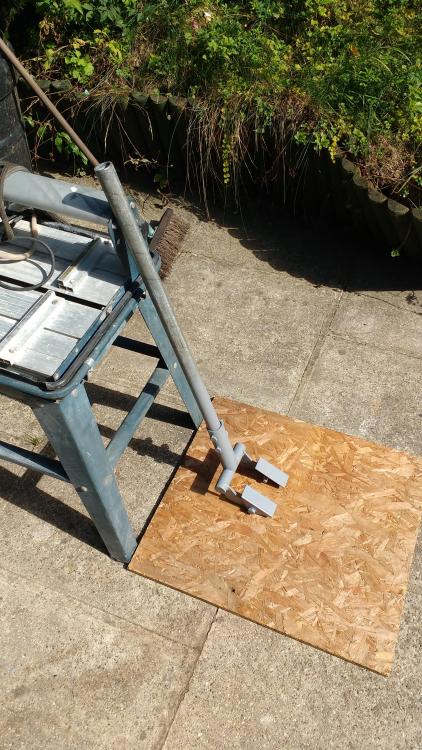Leaderboard
Popular Content
Showing content with the highest reputation on 08/21/18 in all areas
-
3 points
-
No no that's all wrong :-) I'm sure what you meant to say was that it's your lifelong ambition To build your dream house to live in even if it takes you A few goes to get it just right and you have to move a few times in the process. You're sure it will be eXtremely hard building and keeping your day job at the same time but you think you will manage.2 points
-
1. Are the company's claims proven? Absolutely and unequivocally not. I can find no hard, independent, peer-reviewed evidence at all to support their claims. 2. Should we allow companies to be members of our forum? Yes, as long as they don't openly promote their products or seek to gather data from forum members to assist in marketing their products. Any company entering into a discussion on an open public forum knows before they start that open debate is a double edged sword, that can cause them reputational harm as well as reputational enhancement. An old acquaintance of mine, who was a kit aircraft supplier (I was once involved in kit aircraft design and manufacture) refused to join any aviation forum using his real name, or reveal any association with his company, solely because he felt that any customers who had experienced problems would raise them with him publicly, rather than privately, when seeking resolution. He felt, rightly or wrongly, that contented customers would, in the main, keep quiet, and as a consequence only the occasional problem would get a public airing. I'm inclined to think he was right, on balance. People are often quick to seek out forums and social media in order to complain, but far less motivated to do so in order to just say they had good, or acceptable, service, so the overall impression given can easily be very biased.2 points
-
What happened with our build is this: As the designer, I stipulated the frame opening dimensions, to the mm. The frame construction company (MBC) made the frame EXACTLY to those opening dimensions. The window supplier was given a sat of exact frame opening dimensions. They insisted on sending their local chap around as soon as the frame was erected to check that the dimensions that they had quoted against were correct (they were). The window supplier then sent me a final contract, which included a dimensioned drawing of every single window and door, each with a unique reference number and its location. By each window/door drawing there was a box for me to sign to confirm that the dimension, opening directions, spec etc was correct (I literally had to sign and date each and every individual window/door drawing (around 14 of them, IIRC). The window supplier made all the doors and windows 5mm smaller all around *** as a fitting tolerance, to allow them to be slid in relatively easily and wedged up to get them all dead square. They fitted all the windows and doors in less than a day *** and were generally OK. I didn't opt to use their gap filling service but chose to do that myself, primarily because I wanted to be absolutely sure it was as good a job as was possible, and frankly I'm glad I did, as the company in general didn't impress me (although the doors and windows have been fine). The frame supplier wasn't supposed to be involved with the window supplier at all, but when I was having hassle with the window company MBC did go out of their way to help (Joe drove down to Cork and gave the window company bloke a bollocking and told him to engage with his customers more positively, from what I can gather). *** The gotcha was that we had one one window that was 2000mm wide, all the others were smaller. They turned up with two windows 2000mm wide and minus one window that was 1600mm wide. Luckily the reams of drawings that were in the contract, each individually signed, made it clear that they had screwed up, so they took the 2000mm wide window back and returned a couple of weeks late with the correct 1600mm wide one. This incident made me glad I'd had to sign off every individual window and door as a part of the contract.2 points
-
Perhaps a key safe, empty, as a honey trap for thieves and the key hidden elsewhere?2 points
-
No wd40 is a cleaner and will remove any grease/oil that's left. A small squirt of veg oil won't do any harm. Won't last as long as the 3 in 1 but it's still act like a lubricant.2 points
-
It's metastable, so in the presence of water, at standard temperature and pressure, it will want to revert to calcite. If kept dry, or otherwise artificially stabilised (for example by high concentrations of magnesium) it can remain as aragonite, but these aren't conditions likely to be found in domestic water systems.2 points
-
By username and nature! I've reached a point in my life at 50yrs old that its time to build a house. Apologies in advance for having more questions than answers ☺️1 point
-
1 point
-
Not even that. The first guy that quoted £5,200 was doing that I think. This guy knew I had other quotes. I'd told him that they was a wide variation and that I had totally discounted the £5.2.k as being silly. He seemed genuinely gobsmacked that it could be done in a couple of weeks. Jeez - I think I could do it myself, with help from @Onoff, in 10 weeks.1 point
-
1 point
-
I think we paid £8k for about 105m2 - that was for Alumasc render which I really rate. if you do end up leaving the windows open, you can cover them up with poly tunnel polythene. MBC did this for us and it was a godsend given the heavy rain we then had1 point
-
Res bar on the ceilings with two layers of sound block is one of the most cost eftive ways of achieving a high level of soundproofing1 point
-
We are using Gaulhofer windows via Ecowin in our MBC frame. Structural openings, as agreed by us with MBC based on advice from Ecowin, allow for a 12mm tolerance on each side of each window so 24mm overall both horizontally and vertically. Many hours were spent liaising between MBC and Ecowin and they also liaised directly with each other. We, as chief checkers of everything, spent many hours checking and rechecking measurements. Both MBC and Ecowin have been thorough. The final result is not yet known. Windows are on order and should be arriving for fitting next month. We’ll post some updates when that happens.1 point
-
The gaps around the exterior of the Ali frames. You need between 8-12mm on each side so. If your window is 2000mm with 4 panes you’ll need 2*12mm for each end, then the 3*8mm gaps between windows. So Your wooden frames will be be 2000 - 24mm that’s 1976mm wide. Each Ali frame will be (2000-12-12-8-8-8)/4 so that’s 1952/4 giving us 488mm wide sections. From experience if you needed a 500mm escape window.... its worth understanding all this, you will get from Velfac a deeply complex contract that you take the risk on. Lovely windows hard to buy. We did a final review at a trade show with them that really helped..1 point
-
1 point
-
People don't tend to forget easily if they feel they have been wronged. And something that you feel might be the right solution at the time (especially if you have little knowledge of the subject matter) may not be the end of it if later further issues occur that you might relate back to the original work, or if the issues are with the same company. We all have bees in our bonnets about certain areas of our build for sure. Things that eat away at you until you are able to move on and let it go. T'ain't easy though and takes time!1 point
-
With only the most limited of knowledge of the circumstances in question, and with the benefits of hindsight in light of the knock on consequences for the rest of her build, it strikes me that in @lizzie's case rectification may have been insufficient. Perhaps a solution similar to that for @PeterStarck might have been better. That is to cut up the slab, cart it away, and start again. Just an uninformed guess. (For clarification, as I recall MBC had nothing to do with @PeterStarck's build.)1 point
-
@lizzie, I can't help but think that you weren't well served by your PM. For £50k I would have expected you to have had far fewer problems than you did, and with the single exception of the cock up by the concrete floor sub-contractor (first time they'd ever done such a job, apparently) it does seem that the majority of your problems come down to failings by your PM in one form or another. Maybe the Internorm installers were also to blame for some of your woes - they are a reputable company that do seem to be let down by their sub-contracted or franchised supplier/installer network, from what I can gather.1 point
-
I've yet to get to the fitting stage, but my window company, Norrsken, have gone to a great deal of trouble to liaise directly with MBC over structural opening sizes, fitting apertures, indents in the slab for turn and slide doors, etc. I will still be measuring everything once the openings are there, but so far the attention to detail from my window company has been good. They have worked with quite a few timber frame suppliers, including MBC, and are supply and install. Whether reality matches the plan remains to be seen, but I will report back in full once the windows start going in on 24th September.1 point
-
I'm really confused as to how the heck any form of CaCO3 is actually in the mains water. Ignoring all the other elements/compounds for a moment, hard water that only has hardness resulting from calcium, will have the following formula: H2O + Ca2+ + 2HCO3- There is no CaCO3 in the incoming water, so there cannot be any, in any polymorph, in the water leaving your device unless your device somehow causes CaCO3 to be formed and precipitate out. It matters not how this formation and precipitation happens, but the fact is that the solubility of CaCO3 in water is such that it would just dissolve again soon after leaving the unit, and the water would once more turn back to H2O + Ca2+ + 2HCO3- I cannot find any evidence anywhere as to how this process of forming CaCO3 under conditions that are not normally those that would initiate its formation and precipitation from H2O + Ca2+ + 2HCO3- actually happens. What's even more puzzling is how the CaCO3 that is precipitated out of solution in the form of aragonite, isn't then subsequently dissolved again. Of course it's plain nonsense to suggest that calcite enters the device with the incoming water, it cannot, as mains water that is below super-saturation point doesn't contain any calcite at all.1 point
-
I did exactly the same. Like @JSHarris i was the designated desgner and managing contractor/project manager. My wife and I spent many hours checking drawings and specification for everything and produced a wide range of check/interface documents We spent hours checking and crosschecking, We signed off the MBC Timberframe drawings and the windows detailed drawings. We also carried out the same exercise for all our internals doors, for kitchen furniture, for lights, for MVHR ducting, etc, etc. We discussed and agreed fitting tolerances with both the window manufacturer and the door manufacturer, then we used these tolerances to establish the window and door aperture dimensions. Everything went well, except that we had several triangular shaped windows for which, ideally, the fitting tolerance should have been a greater than for standard windows. The same problems was also faced with our main front door, assembly, which is huge and in three pieces - a larger fitting tolerance should have been recommended. A site visit by the window installer, BEFORE finalising the window apertures, would have resolved these fitting tolerance issues1 point
-
I think you were 'lucky' in several ways Jeremy.....you did not have a 'professional' overseeing things for you and you were capable of doing this yourself. Always best if your are competent but I was not so I had to put my trust in a professional third party. MBC were different then too I think they have changed a bit since your day, the bigger a company grows the less hands on and personal it becomes although I was kept at arms length from MBC mostly. I had a numbered window schedule all signed off - that all the sizes were wrong is where the problem arises. Was it the frame supplier or the window supplier who got it wrong......having searched through I found the answers and it appears the person who was paid to co-ordinate this whole thing did not seem to notice where things were awry. Thank god for my trusty carpenter to make the adjustments required.1 point
-
@lizzie has a good idea. A key safe that’s very difficult to locate and when they break into it, it’s empty ?1 point
-
Dissolved calcium doesn't exist in hard water as ready-formed carbonate of any form, but as calcium ions, Ca2+ . Hence the reason that an ion exchange column can swap out calcium ions (Ca2+) for sodium ions (Na+) that the ion exchange medium has already been pre-charged with, leaving the water pretty much calcium free. So, although we know that calcium (and magnesium) rich waters obtained their calcium from dissolving calcium and magnesium carbonates, they don't contain carbonates in solution as such, but rather as calcium and magnesium ions. This is the fundamental problem I have with your statement that: This is flawed basic chemistry. CaCO3 doesn't exist, as such, in the water, as it has been dissolved, it is not in suspension, or held as some form of colloid. Dissolved literally means that the CaCO3 has been broken down to it's constituent elements within the water, in this case Ca2+ cations. The actual solution reaction is this one, and it relies on rainwater that is the start of our drinking water cycle containing dissolved CO2 (which it does, CO2 is, as we all know from fizzy drinks, readily soluble in water): CaCO3 + H2O + CO2 ↔ Ca2+ + 2HCO3- As is transparently clear from the above reversible reaction, the calcium in solution (the right hand side of this equation) is not in the form of CaCO3, in any of its polymorphs, it only exists as Ca2+ cations in solution. You can reverse this reaction readily to get CaCO3 out of solution, this is what happens when the precipitation criteria are met, but this reversal does not take place in normal cold water pipework, so the water flowing into your device does not contain CaCO3, either as calcite or aragonite, it cannot, unless something ahead of the device has caused the above chemical reaction to reverse, not something that normally happens in domestic cold water supplies***. This is the logic behind the point I made earlier that this "catalytic" unit allegedly uses kinetic energy from water flow to cause CaCO3 to form as a precipitate in water that is not super-saturated with Ca2+ cations (it does not exist as precipitate in the incoming hard water whilst it's in solution in the closed pipe system). I'll ask the same question asked above, as it wasn't answered. We are agreed that CaCO3 is readily soluble in water. We know that, when dissolved it is in the form of Ca2+ cations. We also agree that of two of the forms of solid (precipitate) CaCO3, calcite and aragonite, aragonite is significantly more soluble in water than calcite. What process stops the aragonite from being dissolved by the water immediately after the unit and the calcium returning to Ca2+ in solution? How can aragonite exist without being in solution in water that is not saturated? If, for some reason, the incoming cold water supply was super saturated with Ca2+ cations, such that CaCO3 was already precipitating out as calcite, then I can understand how that polymorph could be changed to another, aragonite. It's a process that happens naturally in some dry caves, producing rather nice crystals on dry surfaces, often referred to as aragonite flowers. However, drinking water, even in the hardest water areas in the UK, is massively below the saturation limit. *** There are conditions where CaCO3 can be forced to precipitate out from water that it not super-saturated with Ca2+ cations and which does not become super-saturated as a consequence of drying out. Local high temperature surfaces can cause it to occur (hence the scale build up on heating elements) for example.1 point
-
No its away from the house but still within our plot. ............public forum so not putting location here. pm you.1 point
-
Nothing that's not already been done, all over the net tbh! Anyway IT WORKS! Actually pretty effortless tbh. I might replace the steel tube handle with a bit of thick wall ali tube I scored (30 years ago) as I imagine it could get a lump to wield after a while. I need to trim the M12 bolts that the angles pivot on, this so it can slip over "two inch" main members on pallets. At the mo the distance between angles is nom 54mm. If I reversed the angles so they pointed outward it'd go over a 90mm main member. Happy enough anyway, cost nowt but some leccy, discs and rods.1 point
-
1 point
-
Thanks for that. In my opinion, the document you supplied isn't evidence that would be accepted by anyone with a scientific background. Science aside, it involves a test (not "tests") that happened over 30 years ago, and the original documents upon which it is based are very unlikely to be available for cross-checking. If others are interested, I'm sure they can ask for your document themselves. The Advertising Standards Authority doesn't care what your job title is. If you're making laudatory statements about your company's products in such a way as to encourage people to buy them, then you're advertising, end of. As for aragonite formation, I know my chemistry knowledge is pretty weak, but these two posts seem to contradict each other: Which is it? As I understand it, aragonite is a crystalline solid, hence must be a precipitate. If "Aragonite is formed inside the device", it must therefore "precipitates inside the unit itself", surely? If not, how else is aragonite formed inside the device? This is a fairly simple question that still hasn't been addressed despite having been asked by different posters in different ways.1 point
-
Nor me. I just shove an extension lead through the window or door. Do you have a replacement sink yet? I would get all of the materials ready to complete the job so that you don’t have any down time waiting for bits. You’ll need to order those extension boxes online ....1 point
-
Yes, but the stuff's a pig to get to lay flat in a channel, and requires special termination glands at both ends, so conduit would be both a lot easier, and gives the option of changing the cable, running additional cables etc, later.1 point
-
1 point
-
Precipitation doesn't happen until later, though, long after the water has passed through the device. Precipitation essentially requires some specific conditions in order for it to occur - for example, keep the temperature of a hot water system above the temperature at which CaCO3 comes out of solution as precipitate for a given concentration. Therefore, at the point of treatment there is no calcite, aragonite or valerite. The only thermodynamically stable form of CaCO3 is calcite, so even if this device could somehow cause the dissolved calcium content of the water to "remember" that when it reaches a precipitation point down stream (be that by any means) then it needs to crystallise out as aragonite the precipitate is not going to want to stay as aragonite for long - it will want to revert to calcite. The key thing here is that aragonite is thermodynamically unstable, and will revert to calcite, as that's the lowest energy form of CaCO3, That's interesting because it implies that there should be some energy applied to the system in order to preferentially cause aragonite to form. That's not proof at all. Proof is having the mechanism of operation peer reviewed and reported in a paper in a recognised journal. No recognised scientific journal has ever published any such paper, which seem absolutely extraordinary given the claims that have been made over the decades that this device has been on the market. Take, for example, ion exchange, or phosphate dosing. Both have lots and lots of peer reviewed literature describing in detail the mechanism of action, and both have been reviewed and independently verified in accredited labs so many times that we can be confident in stating that we understand the science behind them and their mechanism of action, plus their performance has been verified beyond reasonable doubt. Client testimonials are simply the placebo effect working. We see exactly the same results with client testimonials being used to support all sorts of fake science, not just water treatment. The reason that it's so damned difficult to prove something by experiment is often because of unconscious bias, it's such a well-known phenomena that several very good peer reviewed papers have been published about the effect and the impact it has. I'm disturbed to read that your advertising makes mention of water softening. By definition, "soft water" is water that has had the calcium and magnesium content reduced. By your own statements your device does not reduce the concentration of calcium or magnesium compounds in the water at all. I know you keep calling the device a water conditioner, but the test in you adverts makes references to "soft water", which is misleading for consumers, in my view. The water leaving your conditioner is not in any way softened; it will have exactly the same concentration of calcium and magnesium as when it entered the device.1 point
-
It'd work a treat I reckon. I think you need the lifting angles pretty much the same width as the board you are lifting to put even pressure across the board and the pivot point dead central. My angles are just <4" long as that's what the bit of scrap angle ended up cut in two. As I say this was made ad hoc with just a feel for what works. Guessing your boards are nailed down with cut nails? Do you have the "scrap" to make one? I could cobble together a "kit" of parts pre cut and give to you with the welder if you wanted or even knock one up (if you're not in a hurry ).1 point
-
1 point
-
Where’s the photo of this Saxon stone then? You can’t just leave that hanging! Will it influence the name of the house? Ethelred the unreadys byre?1 point
-
We found out after the event, velfac have a measuring service... the way they describe their measurements caused no ends of confusion for our lads. You have to account for the shadow gaps from memory.1 point
-
The responsibility is with MBC to set a structural opening size and a finished opening size and for the other two to work to the drawing Suplied While the render can vary across the building it is easy controlled around the windows1 point
-
The sun emits very little long-wave IR (longer than, say, 5 µm compared with its short-wave IR, visible and UV output). Of the little it does put out, most is absorbed by the atmosphere. The long-wave IR reaching a window will come from the local atmosphere and surrounding objects. This has implications for positioning of sunscreens: e.g., a glass canopy might only protect from some of the LW radiation from the sky but not that from the parts of the atmosphere at lower angles and nearby houses, trees, etc.1 point
-
Have you seen the detail issued by Velfac below? The cladding etc doesn't actually go back into the structural opening if you detail it similarly it merely sits flush with and the window overhangs the frame. This might mean your frame dimensions don't need to alter? V200E.W1.04.B.J.001 - Jamb copy.pdf1 point
-
Have the windows been ordered? If not, I'd wait until the render has been done then take your measurements from there. This will cause a delay but I think it would be for the best overall If they have been ordered, then I think you'll have to work with the renderers so that they finish to the right dimensions. The render onto render board isn't that thick so if they're any good they shouldn't be more than a mm or so out, which is nothing in reality. It may be worth speaking to a different renderer too. I can recommend our guys if that helps (Cheshire Facades)1 point
-
Most of us have more questions than answers - and asking is good. The problems for many of us start when we not only don't know the answers ... or even the questions - we don't even realise there is a question to be asked - until we do!! Or we ask the question and don't realise we don't understand the answer - well that's true for me sometimes anyway1 point
-
1 point
-
By the time it had collected in all the corners they would approximate round anyway. ? ==> ?1 point
-
1 point
-
No that wouldn’t take much longer Perhaps an extra half day on boarding Theres a plaster on Ultimate diy Calls himself trowel monkey and seems to be the main one His boast is that he always has a bag of easi fill and goes back the following day and fillls for free Imagine that you’ve just got rid of the dirty buggers and they turn up to make more mess and dust ?1 point
-
1 point
-
1 point
-
On the topic of batteries, this article about how disruptive battery technology can be when used in specific cases is interesting: https://cleantechnica.com/2018/05/15/elon-musk-harpooned-baseload-power/ In essence, Elon Musk took a gamble by making South Australia an offer they couldn't refuse, following major power outages and fluctuating demand that was making wholesale spot market prices vary by thousands of %. He offered to build a large battery storage facility to enhance grid stability for $50M by a set date, if he failed to meet the date the plant would be free. In the first four months of operation it saved $35M, a massive return on a $50M investment. It's an extreme example, created in large part by the chaotic way the power generation system was working (or rather failing) in South Australia, but we're getting to the stage here in the UK where we have enough excess renewable generation to make the wholesale spot market prices go negative very occasionally now. In a couple of years I suspect we'll see negative pricing on a more regular basis, which then makes big battery installations like this look increasingly attractive. I will admit to admiring the way Elon Musk does things; pretty much all he has done has created significant change, from Paypal, through Tesla to SpaceX.1 point
-
Down our way (Hampshire/Surrey borders) not much is negotiable at the moment. Looking at what friends have been through recently, you're lucky enough if you can get anyone to even quote, let alone be open to discussing lower prices. I wouldn't negotiate individual trades down much if their initial quote seems reasonable. The last thing you want is someone cutting corners because a couple of unforeseen issues have popped up and they're losing money on the job. Even with a main contractor, I think it's a false economy trying to squeeze every last penny out of them. Negotiate fairly, but leave something on the table for everyone.1 point


.jpg.c21f3ac78c9b7efd90cbdcb312744dc5.thumb.jpg.7adcad4c0e384f5ecd7d56b0618df6e5.jpg)












